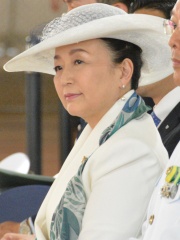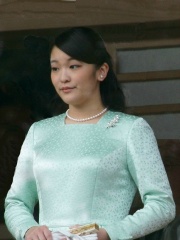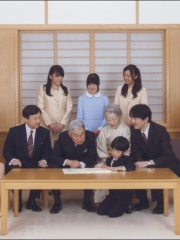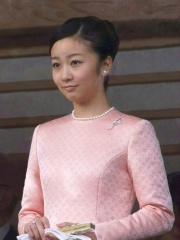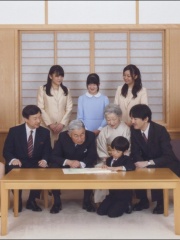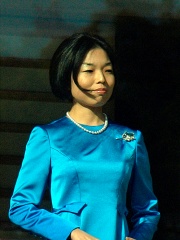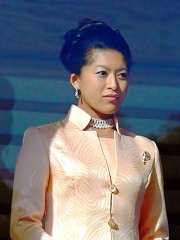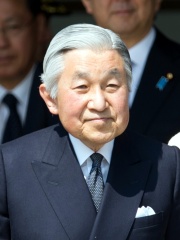
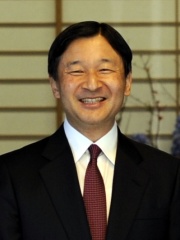
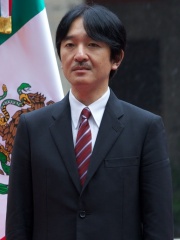
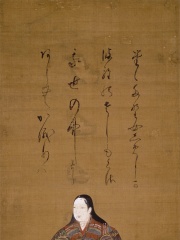
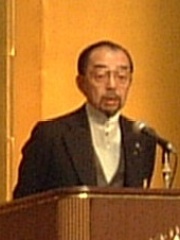
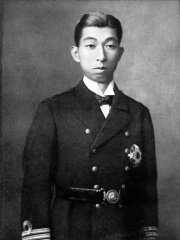
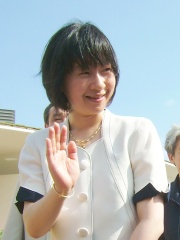
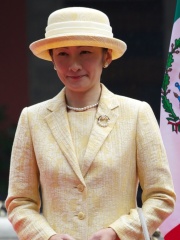
The Most Famous
NOBLEMEN from Japan
Top 10
The following people are considered by Pantheon to be the top 10 most legendary Japanese Noblemen of all time. This list of famous Japanese Noblemen is sorted by HPI (Historical Popularity Index), a metric that aggregates information on a biography's online popularity. Visit the rankings page to view the entire list of Japanese Noblemen.

1. Akihito (b. 1933)
With an HPI of 83.28, Akihito is the most famous Japanese Nobleman. His biography has been translated into 116 different languages on wikipedia.
Akihito (born 23 December 1933) is a member of the Imperial House of Japan who reigned as the 125th emperor of Japan from 7 January 1989 until his abdication on 30 April 2019. The era of his rule was named the Heisei era, Heisei being an expression of achieving peace worldwide. Akihito was born as the fifth child and first son of Emperor Shōwa and Empress Kōjun. During the Second World War, he moved out of Tokyo with his classmates and remained in Nikkō until the surrender of Japan. In 1952, his Coming-of-Age ceremony and investiture as crown prince were held, and he began to undertake official duties in his capacity as crown prince. The next year, he made his first journey overseas and represented Japan at the coronation of Elizabeth II in London. He completed his university education in 1956. In April 1959, he married Michiko Shōda, a commoner; it was the first imperial wedding to be televised in Japan, drawing about 15 million viewers. The couple has three children: Naruhito, Fumihito, and Sayako. Akihito succeeded to the Chrysanthemum Throne and became emperor upon his father's death in January 1989, with an enthronement ceremony in 1990. He made efforts to bring the Japanese imperial family closer to the Japanese people, and made official visits to all forty-seven prefectures of Japan and to many of the remote islands of Japan. He has a keen interest in natural life and conservation, as well as Japanese and world history. Akihito abdicated in 2019, citing his advanced age and declining health, and assumed the title Emperor Emeritus (上皇, Jōkō; lit. 'Retired Emperor'). He was succeeded by his elder son, Naruhito, whose era is named Reiwa (令和). At age 92, Akihito is the longest-lived verifiable Japanese emperor in recorded history. During his reign, 17 prime ministers served in 25 terms, beginning with Noboru Takeshita and ending with Shinzo Abe. He is the oldest living member of the Imperial House of Japan, following the death of Yuriko, Princess Mikasa on 15 November 2024.

2. Naruhito (b. 1960)
With an HPI of 81.60, Naruhito is the 2nd most famous Japanese Nobleman. His biography has been translated into 181 different languages.
Naruhito (born 23 February 1960) is Emperor of Japan. He acceded to the Chrysanthemum Throne following the abdication of his father, Akihito, on 1 May 2019, beginning the Reiwa era. He is the 126th monarch, according to the traditional order of succession. Naruhito was born during the reign of his paternal grandfather, Emperor Hirohito. He was the first child of Crown Prince Akihito and Crown Princess Michiko (later Emperor and Empress). His father acceded to the throne in 1989 upon the death of Emperor Hirohito, making Naruhito the heir apparent. He was formally invested as Crown Prince of Japan in 1991. He attended Gakushūin schools in Tokyo and later studied history at Gakushuin University and English at Merton College, Oxford. In June 1993, he married the diplomat Masako Owada. They have one daughter: Aiko, Princess Toshi. Continuing his grandfather's and father's boycott over the enshrinement of convicted war criminals, Naruhito has never visited Yasukuni Shrine. He is interested in water policy and water conservation. He was an honorary president of the 2020 Summer Olympics and Paralympics and is a supporter of the World Organization of the Scout Movement.

3. Fumihito, Prince Akishino (b. 1965)
With an HPI of 67.08, Fumihito, Prince Akishino is the 3rd most famous Japanese Nobleman. His biography has been translated into 44 different languages.
Fumihito, Crown Prince Akishino (秋篠宮皇嗣文仁親王, Akishino-no-miya Kōshi Fumihito Shinnō; born 30 November 1965, Japanese: [ɸɯmiꜜçi̥to]) is the heir presumptive to the Japanese throne. He is the younger brother of Emperor Naruhito, and the younger son of Emperor Emeritus Akihito and Empress Emerita Michiko. Since his marriage in June 1990, he has had the title Prince Akishino (秋篠宮, Akishino-no-miya) and has headed the Akishino branch of the Imperial House of Japan. Fumihito has a bachelor's degree in political science from Gakushuin University and a Doctor of Philosophy degree in ornithology from the Graduate University for Advanced Studies. In 1990, he married Kiko Kawashima, with whom he has three children: Mako, Kako, and Hisahito. In November 2020, Fumihito was officially declared the heir presumptive to the throne, during the Ceremony for Proclamation of Crown Prince (Rikkōshi-Senmei-no-gi) in Tokyo. Preceding his investiture as Crown Prince, the ongoing Japanese imperial succession debate had resulted in some politicians holding a favorable view on rescinding agnatic primogeniture, which was implemented in 1889 and reinforced on the constitution of Japan by the Allies after World War II. However, once Fumihito and Kiko had their son Hisahito in September 2006, he became next in the line of succession following his father. Fumihito's niece and Emperor Naruhito's only child, Princess Aiko, remains at present legally ineligible to inherit the throne, while debate about the possibility of having future empresses regnant continues. As active working members of the imperial family, Fumihito and his wife Kiko's schedule includes attending summits, and organisational and global event meetings. The couple have particularly represented the Japanese imperial house in ceremonies involving heads of state and VIPs abroad.

4. Yodo-dono (1569 - 1615)
With an HPI of 65.74, Yodo-dono is the 4th most famous Japanese Nobleman. Her biography has been translated into 16 different languages.
Yodo-dono (淀殿) or Yodo-gimi (淀君; [jo.do(ꜜ).ɡʲi.mʲi, -ŋʲi.mʲi], 1569 – June 4, 1615), also known as Lady Chacha (茶々; [tɕaꜜ.tɕa]), was a Japanese historical figure in the late Sengoku period. She was the concubine and the second wife of Japanese ruler Toyotomi Hideyoshi. As the mother of his son and successor Hideyori, she acted as Hideyori's guardian in the restoration of the Toyotomi clan after the fall of the Council of Five Elders, and alongside her son, led the last anti-Tokugawa shogunate resistance in the siege of Osaka. She was the daughter of Oichi and sister of Ohatsu and Oeyo. When her two younger sisters became prominent members linked to the Tokugawa clan, she and her sisters became vital to maintaining the diplomatic relations between the two most powerful clans of the time, Toyotomi and Tokugawa. Her sister, Oeyo, was the wife of the second shogun, Tokugawa Hidetada, and matriarch of the successive shoguns' lineage, thus receiving the political title Omidaidokoro. In the efforts to exalt the Tokugawa Shogunate, Yodo-dono was frequently portrayed as a "wicked and wanton" woman who planned the Toyotomis' death. After Hideyoshi's death in 1598, she took tonsure as a Buddhist nun, taking the name Daikōin (大広院). She was also the founder of the temple Yogen-in (養源院). Her time period being that of large turmoil and overhaul, Yodo-dono was involved in both politics and administration. The great wealth and changing fortunes of her family had also affected Yodo-dono's life. The surviving accounting books from luxury goods merchants provide insight into the patterns of patronage and tastes amongst the privileged class of women like Yodo-dono and her sisters.
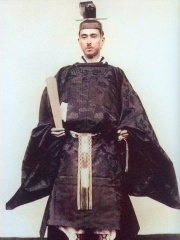
5. Prince Yasuhiko Asaka (1887 - 1981)
With an HPI of 62.09, Prince Yasuhiko Asaka is the 5th most famous Japanese Nobleman. His biography has been translated into 19 different languages.
Prince Yasuhiko Asaka (朝香宮鳩彦王, Asaka-no-miya Yasuhiko-ō; 20 October 1887 – 12 April 1981) was the founder of a collateral branch of the Japanese Imperial Family and served as a general in the Imperial Japanese Army during the Japanese invasion of China and the Second World War. He was the son-in-law of Emperor Meiji and uncle by marriage of Emperor Hirohito. He is most notable for being the commander of Japanese forces outside Nanjing in December 1937, when he presided over the mass murder and rape of hundreds of thousands of Chinese soldiers and civilians in during the Nanjing Massacre. After Japan's defeat in World War II, General Douglas MacArthur granted immunity to the country's Imperial Family. As a result, Asaka was never tried for his involvement in the Nanjing (Nanking) Massacre by SCAP authorities. Nonetheless, by 1947, he and his children were stripped of their imperial status. He later converted to Catholicism and died of natural causes at the age of 93.

6. Prince Tomohito of Mikasa (1946 - 2012)
With an HPI of 60.87, Prince Tomohito of Mikasa is the 6th most famous Japanese Nobleman. Her biography has been translated into 21 different languages.
Prince Tomohito of Mikasa (寛仁親王, Tomohito Shinnō; 5 January 1946 – 6 June 2012) was a member of the Imperial House of Japan and the eldest son of Takahito, Prince Mikasa and Yuriko, Princess Mikasa. He was a first cousin of Emperor Akihito, and was formerly sixth in the line of succession to the Japanese throne and the heir apparent to the princely house of Mikasa-no-miya and the title "Prince Mikasa". Prince Tomohito was the first member of the Imperial House of Japan with a full beard since Emperor Meiji, thus earning him the popular nickname of the "Bearded Prince" (ヒゲの殿下 Hige no Denka). He died of cancer on 6 June 2012, aged 66.

7. Nobuhito, Prince Takamatsu (1905 - 1987)
With an HPI of 60.52, Nobuhito, Prince Takamatsu is the 7th most famous Japanese Nobleman. His biography has been translated into 19 different languages.
Nobuhito, Prince Takamatsu (高松宮宣仁親王, Takamatsu-no-miya Nobuhito Shinnō; 3 January 1905 – 3 February 1987) was the third son of Emperor Taishō (Yoshihito) and Empress Teimei (Sadako) and a younger brother of Emperor Shōwa (Hirohito). He became heir to the Takamatsu-no-miya (formerly Arisugawa-no-miya), one of the four shinnōke or branches of the imperial family entitled to inherit the Chrysanthemum Throne in default of a direct heir. From the mid-1920s until the end of World War II, Prince Takamatsu pursued a career in the Japanese Imperial Navy, eventually rising to the rank of captain. Following the war, the prince became patron or honorary president of various organizations in the fields of international cultural exchange, the arts, sports, and medicine. He is mainly remembered for his philanthropic activities as a member of the Imperial House of Japan.

8. Sayako Kuroda (b. 1969)
With an HPI of 58.36, Sayako Kuroda is the 8th most famous Japanese Nobleman. Her biography has been translated into 35 different languages.
Sayako Kuroda (黒田 清子, Kuroda Sayako; born 18 April 1969), formerly Sayako, Princess Nori (紀宮清子内親王, Nori-no-miya Sayako Naishinnō), is the youngest child and only daughter of Emperor Emeritus Akihito and Empress Emerita Michiko, and the younger sister of the current Emperor of Japan, Naruhito. She is an imperial Shinto priestess of the Ise Grand Shrine, currently serving as the Supreme Priestess. Kuroda held the appellation "Nori-no-miya" (Princess Nori), until her marriage to Yoshiki Kuroda on 15 November 2005. As a result of her marriage, she gave up her imperial title and left the Japanese imperial family, as required by the Article 12 of the Imperial Household Law, and received a payment of approximately US$1,000,000.

9. Kiko, Princess Akishino (b. 1966)
With an HPI of 58.35, Kiko, Princess Akishino is the 9th most famous Japanese Nobleman. Her biography has been translated into 38 different languages.
Kiko, Crown Princess Akishino (皇嗣文仁親王妃紀子, Kōshi Fumihito Shinnō-hi Kiko) (born Kiko Kawashima (川嶋紀子, Kawashima Kiko); 11 September 1966) is a member of the Imperial House of Japan. She is married to Crown Prince Fumihito, the heir presumptive to the Japanese throne. Kiko earned a doctoral degree in humanities from Ochanomizu University. Her marriage to Crown Prince Fumihito in 1990 reflected a trend in which members of the imperial family married academically accomplished commoners from the middle class, continuing a pattern observed in previous and current generations. The couple has three children: Princess Mako, Princess Kako, and Prince Hisahito. Prior to their investiture as Crown Prince and Crown Princess, the ongoing Japanese imperial succession debate had prompted discussions among some lawmakers about revising the male-only succession rule (agnatic primogeniture) established by the Allies of World War II in the postwar constitution of Japan. The birth of Prince Hisahito in September 2006, however, secured the line of succession for male heirs, placing him immediately after his father. Hisahito's cousin, Princess Aiko, the only child of Emperor Naruhito, remains legally ineligible to inherit the throne, though debate continues over the potential for future empresses regnant. As active working members of the imperial family, Kiko and Crown Prince Fumihito regularly participate in official duties, including attendance at summits, organizational meetings, and international events. They frequently represent the Imperial Household at ceremonies involving heads of state and other dignitaries abroad. Kiko’s patronages focus primarily on medical, scientific, and children’s welfare initiatives.
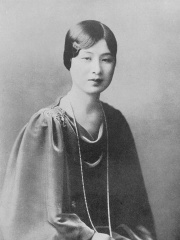
10. Kikuko, Princess Takamatsu (1911 - 2004)
With an HPI of 55.87, Kikuko, Princess Takamatsu is the 10th most famous Japanese Nobleman. Her biography has been translated into 17 different languages.
Kikuko, Princess Takamatsu (宣仁親王妃喜久子, Nobuhito Shinnōhi Kikuko), born Tokugawa Kikuko (徳川喜久子; 26 December 1911 – 18 December 2004), was a member of the Japanese imperial family. The Princess was married to Nobuhito, Prince Takamatsu, the third son of Emperor Taishō and Empress Teimei. She was, therefore, a sister-in-law of Emperor Shōwa and an aunt by marriage of the following emperor, Akihito. She was mainly known for philanthropic activities, particularly her patronage of cancer research organizations. At the time of her death, Princess Takamatsu was the oldest member of the Imperial Family.
People
Pantheon has 19 people classified as Japanese noblemen born between 1569 and 2006. Of these 19, 14 (73.68%) of them are still alive today. The most famous living Japanese noblemen include Akihito, Naruhito, and Fumihito, Prince Akishino. The most famous deceased Japanese noblemen include Yodo-dono, Prince Yasuhiko Asaka, and Prince Tomohito of Mikasa.
Living Japanese Noblemen
Go to all RankingsAkihito
1933 - Present
HPI: 83.28
Naruhito
1960 - Present
HPI: 81.60
Fumihito, Prince Akishino
1965 - Present
HPI: 67.08
Sayako Kuroda
1969 - Present
HPI: 58.36
Kiko, Princess Akishino
1966 - Present
HPI: 58.35
Princess Tomohito of Mikasa
1955 - Present
HPI: 55.26
Princess Mako of Akishino
1991 - Present
HPI: 52.16
Aiko, Princess Toshi
2001 - Present
HPI: 52.12
Princess Kako of Akishino
1994 - Present
HPI: 51.46
Prince Hisahito of Akishino
2006 - Present
HPI: 49.30
Princess Akiko of Mikasa
1981 - Present
HPI: 47.16
Princess Tsuguko of Takamado
1986 - Present
HPI: 44.88
Deceased Japanese Noblemen
Go to all RankingsYodo-dono
1569 - 1615
HPI: 65.74
Prince Yasuhiko Asaka
1887 - 1981
HPI: 62.09
Prince Tomohito of Mikasa
1946 - 2012
HPI: 60.87
Nobuhito, Prince Takamatsu
1905 - 1987
HPI: 60.52
Kikuko, Princess Takamatsu
1911 - 2004
HPI: 55.87
Overlapping Lives
Which Noblemen were alive at the same time? This visualization shows the lifespans of the 4 most globally memorable Noblemen since 1700.

